EWB Research Field Site Update
This year, our field work came to an early start and on a much grander scale than in previous years. Early January, Mike put together a team of 8, packed up the trucks with equipment and supplies and headed out past Chobe National Park and several villages, into the Chobe Enclave to begin construction of EWB’s research field camp and agricultural trial/demonstration plots.
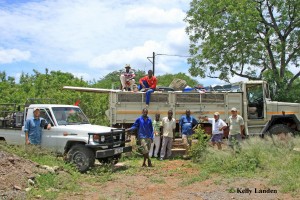
Dr. Chase and team ready to begin!
The main purposes of the site will be to assess methods and low-cost techniques that work best to reduce elephant crop raiding, train villagers in deterrence methods and productive conservation farming methods, and to motivate community involvement in human-elephant conflict (HEC) resolution and adopt wildlife conservation practices. (see EWB ‘s People & Elephants web page) The site is in a perfect location for this purpose, as it is within a half hour’s drive of “high-conflict” villages and yet far enough into the bush to be utilized by large concentrations of game. The team encountered elephants, giraffe, eland, impala, buffalo, ostrich, and a vast amount of zebra. Following their prey, the predators were close behind. Lions, leopards and hyenas called through the night, leaving little rest for the weary.
The first thing that had to happen was to set up a modest base camp to accommodate the team. A small area was cleared, tents put up, and a kitchen area designated. Our camp cook, Lucky-man Frank, was chuffed when we upgraded his “kitchen” with a letaka enclosure and a gas-powered freezer!
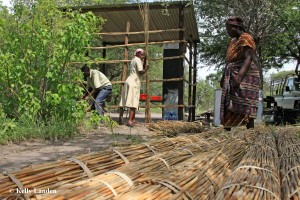
Lydia and Esther prepare letaka for Frank's kitchen
Which is clearly needed, considering the continual heat. Most days, they begin work at first light, having a short break mid-morn, but take a very long lunch avoiding work in the extreme heat of the day, then out again until sunset. With basic needs met, the next step was to delineate the property boundaries by marking GPS points, clearing thin property cut-lines. The area’s natural layout made it easy to decide where the fields would be ploughed and that the permanent camp would be erected on a forested ridgeline overlooking the site’s natural pans. The team spent weeks removing large stumps from designated areas. A tractor was hired from the communities and plowed several plots, some of which traditional crops of corn and sorghum were planted immediately.
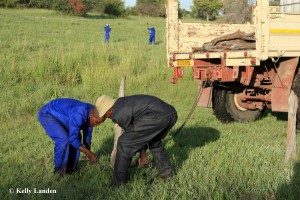
Doo and Patrick chain a stump to the truck to pull it out
Despite it being the rainy season, with seeds in the soil, it was necessary to bring water to the property. Digging a bore-hole is a huge endeavor, has quite an unpredictable outcome, but an extremely necessary expense.
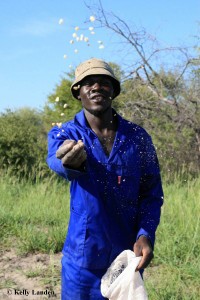
Shoni planting glorious corn
I didn’t know what to expect and was completely surprised at the amount of trucks and equipment needed to dig a well! Six large trucks arrived, carrying the drill, pipes, water, fuel, generators, and some! (Who supports EWB? to see, click here)
Of course, to begin we had to decide where to drill the hole. Most people say successful drilling is pure luck, but water dousing, “water witching,” is an old craft which many still believe in. There is no scientific explanation to a “Y-shaped” twig bending strongly in a certain direction as a reaction to the presence of water, however it does seem to happen. I was given a quick lesson and felt it for myself. Branches from the first shrubs that bear leaves and fruit in the Spring, such as the brandy or mulberry bush, should be the tool used because of their flexibility. Most branches snap under the pressure of the exercise! However, there are natural clues to look for while tracing underground water, too. First, we looked at the wildlife paths.
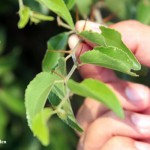
Buffalo thorn are a clue to underground water
Strangely enough elephants seem to make continual paths over lines which are higher on the water table. Shifts in the ground, close to ridge-lines, water is moving. In places like ravines, water is stagnant. Large trees, especially Buffalo thorn, growing in straight lines are another clue. After considerations, our drilling point was finally chosen and the trucks maneuvered into position.
The bit, which is less than a foot wide, hit the ground vibrating. Sandy soil came spewing up, as the drill went down. It was interesting to watch layer after layer of the various sand and soils that lay below. Every 5 meters, a new pipe had to be added at the top to continue deeper. We had assumed we’d find water quickly, but were wrong. At about 15 meters, the sand was moist, and as it continued, the soil became wet. But we still had not hit flowing water. At approximately 18 meters, thick chunks of bluish-white clay began to spew out from the narrow hole. This made the drilling team concerned because clay is so fine that it does not allow for the water to flow, so we had to drill deeper.
thick clay came from 20 meters below
Finally, just over 25 meters, a great release in the thickness rose, and all of a sudden, we had water! The drillers checked the flow and advised us that we should dig just slightly deeper to yield a better outcome. We drilled another 5 meters before hitting hard rock again and the decision to halt was made. The water was tested again for flow and salinity and we were relieved to hear that we had “good” water now available for the crops and camp.
The camp and fields still need a lot of work, as we are still in the initial stages and need to secure more funding, but slowly it is coming together. It has been helpful that the rains decided to cooperate, too. We talked to many researchers and various organizations to incorporate their knowledge, past experiences and skills towards the site’s endeavors and potentially work together to resolve the issues we are trying to address. We are particularly excited about these potentials and are appreciative of all the input and support we have received. We will keep news and progress posted…
Please help support EWB’s endeavors by Donating now! How? just click here! Thank you!
Alex was eager and among the first to taste the water
Tags: africa, agriculture, botswana, conservation, elephants, HEC, human-elephant conflict, research







